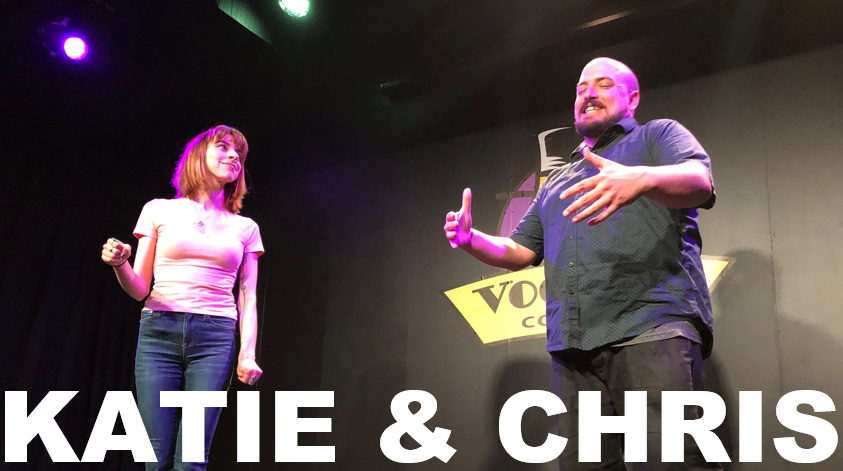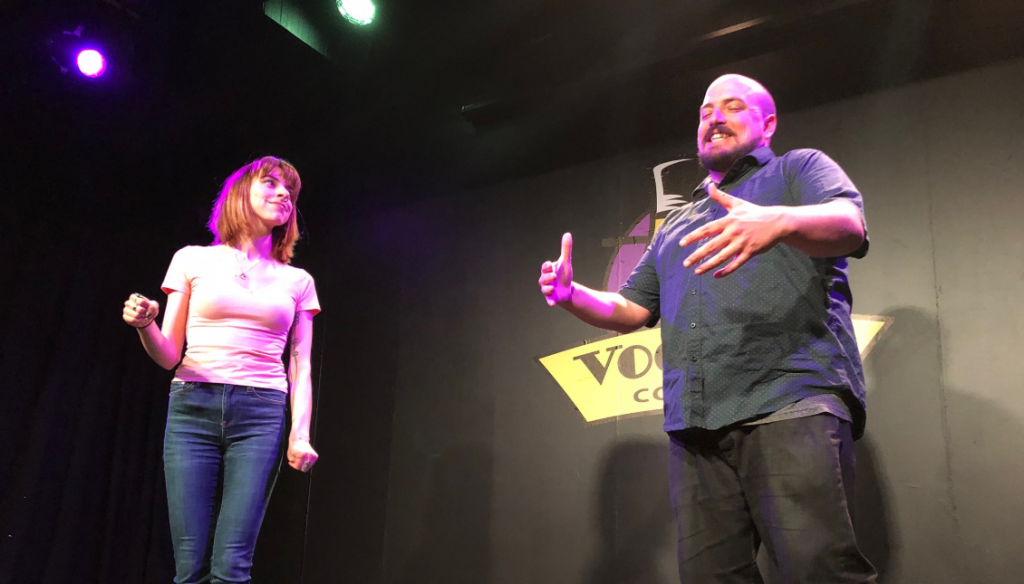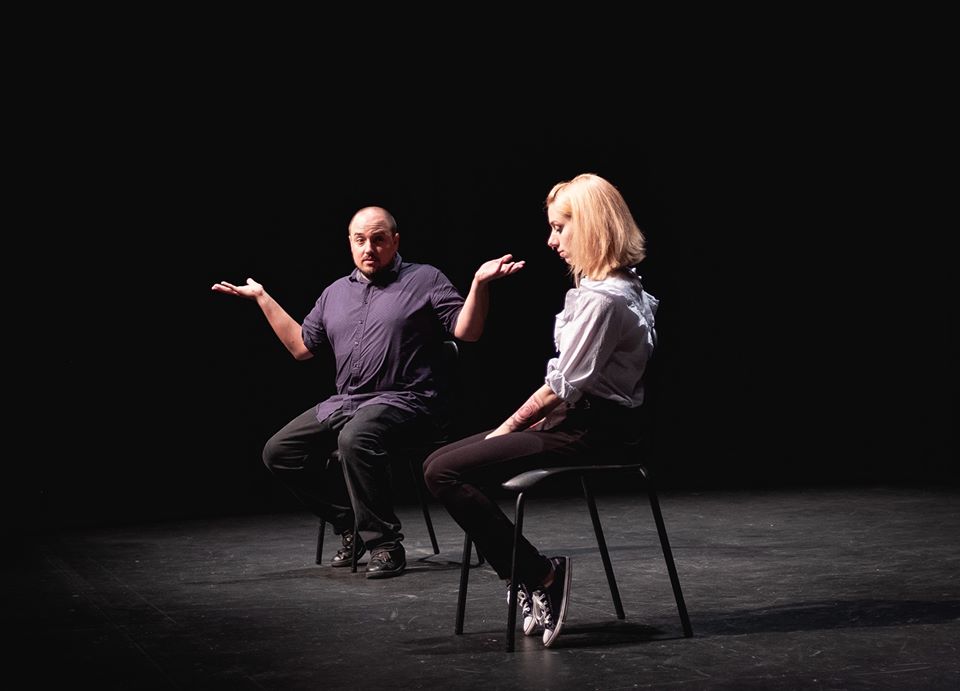Katie & Chris love to bring their unique perspectives together in improv comedy. They use slow, organic discovery of the moment, as well as quick, premise-oriented scenes, to create their two-person improv show. You may even catch a musical number! Together, they like to tell deep stories, create one-of-a-kind characters, and have just as much fun as the audience does watching.
Katie Matthews, Chris Teregis
Denver, Colo.
Previous Countdown Improv Festival appearances
2020, 2019
Images


Video
Troupe bio
Katie & Chris met as instructors and producers at Grafenberg Theater in Denver, Colo. They first discovered their complimentary voices while writing and performing improvised sketch in Grafenberg’s weekly Writer’s Block show. Katie & Chris began performing their two-person show not long after, experimenting with their premise-based approach to improvised sketch, as well as utilizing their training at places like UCB LA, iO West, and the iO Chicago and Annoyance styles passed down through Grafenberg Productions in Denver. Now, Katie & Chris continue to combine their unique perspectives on improv — including slow, organic discovery, as well as premise-based game — to create their two-person improv show. Together, they like to tell deep stories, create one-of-a-kind characters, and have just as much fun as the audience does watching. They currently are instructors, performers, and producers at Rise Comedy in Denver, where they produce Your World Record, an improv show that also sets brand-new world records.
Interview (from 2019)
We’re really looking forward to having you with us this year! Tell us about your show format. Why does it work for you? What can audiences expect from Katie & Chris at the festival?
We have experimented with various formats over time and have always tried to do things that we find really fun. We’ve done things from monoscenes to sets where every scene starts like the beginning of a knock-knock joke. Most regularly, we LOVE digging into character perspectives and finding little things throughout our sets to heighten and play with. This taps into Chris’s love of pattern and heightening and Katie’s love of character and organic discovery. Regardless of the exact format we take, audiences should expect to see a story about two characters that, at the end of the day, really care about each other!
You two have a great rapport on stage. When did you first decide to start performing together? How has your on-stage dynamic evolved since your duo began, if at all?
We met a couple years ago when Chris moved to Denver from LA and started advertising free improv workshops in a local library. Spoiler alert: It was a baller time. He brought out a style that wasn’t heavily seen in the Denver scene at the time and was really fun and unique. Eventually, he joined the faculty at Grafenberg Theater, where we used to teach, produce, perform, and had our first opportunity performing together on a larger ensemble the Grafenberg Players.
We soon started toying with the idea of trying a two-person set. We tried a few sets and really loved it. I (Katie) had never felt more like someone had my back on stage in the way that Chris did, and I (Chris) am addicted to how generous and mindful Katie can be, while at the same time, making definitive choices and capitalizing on opportunities. We’ve now been playing together a while and host and perform in a show called Your World Record at Voodoo Comedy, which showcases teams around the Denver improv community and gives audiences members to set brand new world records like “Fastest time to unravel a toilet paper roll while playing Happy Birthday on a kazoo” (record currently held at 3 minutes) or “Most times to put a watermelon through a wire hanger using only your feet in 2 minutes” (it’s more times than you think!).
When we first started playing together as our two-person team, we wanted to support each other so much that we would defer to each other too much and scenes would stall out a bit. Now, we really try to parallel our off-stage dynamic on-stage by putting our energy into elevating each other’s ideas and augmenting what the other person established into more of what it already is.
How do you define a good show? And is your internal definition of what constitutes a good show sometimes different from what the audience interprets as a good show?
Our definition of a good show is really a gut thing. If we come off stage with that warm feeling you get in your gut and we feel really connected, then it was a good show. This doesn’t necessarily always correlate with the audience’s reaction, but we really try to improvise from a place that first honors our stories and choices, rather than to first please the audience (though that’s always the end goal, too ☺︎). If we do our jobs right to listen and support each other, then we can usually get the audience on board for the journey with us.
You both teach improv, as well. How does your teaching influence your performing, and vice versa? (And it’s fine if the answer is “it doesn’t”!)
Yes! We both love teaching so much. I (Katie) love to be able to use my own experiences performing, as well as examples of others’ performances, to drive concepts in classes and rehearsals. I’ve found that being able to relate to students’ experiences on stage so directly can be really helpful, and after all, improv is about being in this together! My teaching has also definitely impacted my performing. It’s a great way to keep mindful of some of the core principles we strive to live and perform by as improvisers. I remember a time when I was feeling really in my head and like stakes were really high on my performances, and before one show, I made a conscious choice to take some of the advice I had recently given in one of my classes (that I originally heard from my own mentors and teachers) to “not try.” So instead of trying to be a “good” improviser, I went in assuming I’d come out the other side having done an “adequate” job. I had more fun and felt more in the moment in that set than I had in a while, so this is now a regular thing I tell myself before every set.
I (Chris) love teaching and I am grateful for every opportunity. It is delightful to work with the eager and talented community in Denver. There are few things on this planet that make me happier than watching the dedicated students and teams I coach get up on stage and crush (excuse my lingo dudes and dudettes – I am from California). Teaching really helps keep me sharp and focused, and I enjoy the mild pressure of having students in an audience. I enjoy feeling the need to actively demonstrate the principles, practices, and values that I teach on a regular basis. Creating safe spaces for my students has also led me to a much more mindful existence on stage and off. I’m very lucky to be able to teach in Denver.
You’re both from Denver, a beautiful city with a robust improv scene. Is there a defining “Denver style” of improv? What makes your city’s scene unique?
The thing that makes Denver really great is that there is actually a good amount of diversity in the styles of improv that you will see out of all the teams and performers. We have teams you’ll see regularly practicing fast-paced, premise-based game, others that use organic openers and edits and play more “low and slow,” voices that lean more toward the fantastical, and others who love to play super real. The three theaters – Voodoo Comedy, Bovine Metropolis, and Grafenberg – each have their own unique take on improv in their regular shows and training programs, but there is also variety at each of them. We really love Denver’s scene, because no matter who you are or what you’re into improv-wise, you can find your niche and community here and be totally supported to “do you.”
What’s the most unusual place you’ve ever performed, together or separately?
Oof, good question! It’s not terribly unusual, but prior to Grafenberg opening its own theater space, we would produce shows out of more indie spaces – one of which was a space in the back of an old bar in Denver called Comedy RoomRoom that was mostly used for stand-up shows. The stage was probably 3’ by 5’ and in a long, narrow room. At the time, we weren’t performing as Katie & Chris, but our teams often had to get creative to use the floor space around the stage or the first couple rows of the audience. It was always a super intimate show experience which resulted in some really fun sets.
Chris also once performed an improv set opening for a Juggalo-style rap group inside of a warehouse in Orange County, California. There were no laughs, just very confused Juggalos.
Finally, how many times per month do you go to Casa Bonita? (Please explain if the answer is less than five.)
This answer is going to be so disappointing… Katie has actually never been to Casa Bonita after living in Denver for over 6 years. She wants and intends to go, based on the glorious-hellscape-like descriptions she hears.
Chris has lived here about 2 years and has gone once. Casa Bonita is a wildly strange place and is definitely something everyone should experience at least once. I (Chris) may take a friend there if they visit, but that’s it. The food is overpriced and awful, and when I say awful, I mean borderline inedible, but choking it down is part of the experience. The shows are very strange. There’s a weird puppet show, an arcade that hasn’t been updated since 1998 (Cruisin’ USA 4 LYFE), a maze… I don’t know. Everything you have heard about it is probably true, if even less weird than the reality of Casa Bonita.

